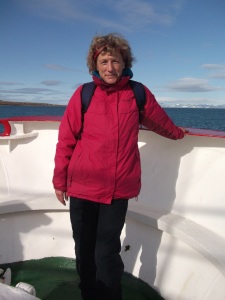This guest blog, by Lesley Harrison, is one of several which will appear here and focus on cross-disciplinary interpretations of the coast. It covers also community engagement and, I’m very happy to say, builds on some of the discussions at the recent ‘Firths and Fjords’ conference. Lesley is a PhD student at the University of Hull, whose research explores poetries of place along the North Sea coast. In interrogating terms like ‘seascape characterisation’, ‘coastal edge’ and ‘soft coasts’, Lesley’s post has much to offer all of us working on littoral places and their people. Her blog can be found here: auchmithiecalendar.wordpress.com [David]
 It was a great pleasure to attend ‘Firths and Fjords’ in Dornoch. As a non-historian, I appreciated the chance to view the coastline from a historian’s multi-layered, multi-disciplinary perspective, and I have found myself referring back to the many interesting, detailed presentations since. This week I attended the Tay Estuary Forum Annual Conference (2016) at the University of Dundee. The Forum is a multi-disciplinary, multi-agency group. The topic of the conference was the ongoing quest to define and describe the coastline, an entity which by its shifting nature evades definition.
It was a great pleasure to attend ‘Firths and Fjords’ in Dornoch. As a non-historian, I appreciated the chance to view the coastline from a historian’s multi-layered, multi-disciplinary perspective, and I have found myself referring back to the many interesting, detailed presentations since. This week I attended the Tay Estuary Forum Annual Conference (2016) at the University of Dundee. The Forum is a multi-disciplinary, multi-agency group. The topic of the conference was the ongoing quest to define and describe the coastline, an entity which by its shifting nature evades definition.
Dr Tim Stojanovic, Lecturer in Sustainable Development and Geography at the University of St Andrews, presented a paper on the use(s) of the term ‘seascape’ in planning and management. Tim identified what can be a lack of clarity of concept and vocabulary in coastal studies, a theme also highlighted by Professor Land at Dornoch.
Seascape Characterisation is a formal process conducted using a variety of methods and for a variety of purposes and on a range of scales, from the very local to entire local authority regions. The lack of consistency of approach, says Tim, has led to a lack of comparability of sites, as well as difficulties in integrating data about our coast. As the purposes and funders of seascape assessment have evolved over time, so have methodologies and vocabularies.
For example, in Scotland, since 1994, Landscape Character Assessments (LCAs) have included the requirement to describe Coastal Character Types and Areas. These have been done with increasing attempts at accuracy in description, with the result that among the 29 local authority studies there are now 77 different coastal ‘types’. Shetland’s 1994 LCA distinguished different kinds of views from adjacent coastlines, or ‘from land to land’; all other stretches were described as ‘coastal edge’. Skye and Lochalsh, on the other hand, included ‘fjords’, ‘narrows’ and ‘islands’ in their 1996 LCA. Approaches to seascape characterisation have also diverged considerably between Scotland and the rest of the UK. Local studies in the other nations may extend the boundaries of the ‘seascape’ well offshore, even up to around 12 nautical miles, to include relevant heritage/ecological resources.
Tim’s draft paper acknowledged a truth that also emerged in our panel discussions: that the boundary of sea and land provides us with a precious, intimate experience which is in part a kind of self-recognition. I remembered sitting in the evening sunshine in Dornoch Cathedral, listening to Professor Gillis describing our relationship with the shoreline as ‘topophilia’, and the consequences of becoming alienated from our ‘origin-place’. The paper refers to the Seascape Wheel (Natural England) as one practical method of recognising the many complex qualities that constitute a ‘seascape’, and the broad range of stakeholders that should be recognised in coastal development.
Also of particular interest perhaps to ‘Firths and Fjords’ people was the presentation by Jim Densham, Senior Land Use Policy Officer for RSPB Scotland. Jim lamented the no-mans’-land of our ‘soft coasts’, which are often overlooked by marine policies and land law, and explained the longer term consequences of removing natural tidal zones by creating hard sea defences.
His case study of a field in Nigg Bay was fascinating. An old sea wall protected the pasture, but the farmer was happy to sell the field as returns had never been very great. The RSPB purchased it in 2003, and breached the sea wall in two places, at the points where, according to old maps, creeks drained the marshy ground. Over time, the field reverted to saltmarsh, and the marsh acted as a natural buffer between the tidal surge and the fields inland.
The Tay Estuary Forum demonstrated, as we did at ‘Firths and Fjords’, that the model of a semi-formal, multi-disciplinary forum definitely works! Debate was free, wide-ranging and inclusive. (And the food was good – but as good as Dornoch? Hmmm.)
